Faceted Gemstones - Everything you need to know about Faceted Gems
21 Jun 2020
0 Comments
Cabochon Vs. Faceted:
Cabachon: The cabochon is a type of cut that has a convex top with a flat bottom. Typically, cabochon cut is applied to opaque gemstones and has one flat surface which could be round or oval-shaped. Faceting: Faceting is a type of cutting in which the surface of a gem is covered with several flat surfaces; each of these flat surfaces is called ‘Facet.’ It acts as mirrors that allow light to enter the gem and reflect it back to the viewer from the face of a gemstone. VS
VS  Gem Cutting Terminology:
Gem Cutting Terminology:
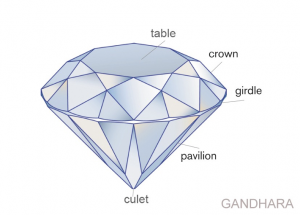 Crown: The top of a faceted gem is called the crown; this is the area above the girdle. Usually, when you look at the “face” of a gemstone, you will see this area.
Table: The flat facet on the crown is called table facet, which is the one that acts as a window into the interior of the gem.
Girdle: The fullest part of the gem represents the girdle; it defines stones outline, also called the base layer of a cut gemstone.
Pavilion: The bottom of a faceted stone is the pavilion, the area underneath the girdle. It can be faceted into many shapes to enhance gemstone brilliance.
Culet: The pavilion’s bottom is culet, also known as the base or flat back of the gemstone. It is the highly customizable part of a gem. Sometimes, you will see tiny, flat culets instead of pointing; this helps to protect the pavilion’s edges from damage. But in other faceting styles, including emerald, princess and radiant cut, you do not have a culet.
Brilliance (brightness, luminosity, radiance): Every cutter aims to achieve a polished gem with the highest brilliance. Brilliance depends on the luster of the stone and the dispersion of white light entering the gem’s crown, producing the effect of fire. The term ‘effect of fire’ used to describe the rainbow-like flashes of color that are visible in other gemstones, such as sphene and zircon. This effect is best seen in colorless or lightly colored gems since deeper, more vibrant colors tend to hide the effect. Regarding colored gemstones, a cutting style must be selected to emphasize the depth of color viewed through the crown facet.
Gem Value Factors:
The 4 C’s:
Crown: The top of a faceted gem is called the crown; this is the area above the girdle. Usually, when you look at the “face” of a gemstone, you will see this area.
Table: The flat facet on the crown is called table facet, which is the one that acts as a window into the interior of the gem.
Girdle: The fullest part of the gem represents the girdle; it defines stones outline, also called the base layer of a cut gemstone.
Pavilion: The bottom of a faceted stone is the pavilion, the area underneath the girdle. It can be faceted into many shapes to enhance gemstone brilliance.
Culet: The pavilion’s bottom is culet, also known as the base or flat back of the gemstone. It is the highly customizable part of a gem. Sometimes, you will see tiny, flat culets instead of pointing; this helps to protect the pavilion’s edges from damage. But in other faceting styles, including emerald, princess and radiant cut, you do not have a culet.
Brilliance (brightness, luminosity, radiance): Every cutter aims to achieve a polished gem with the highest brilliance. Brilliance depends on the luster of the stone and the dispersion of white light entering the gem’s crown, producing the effect of fire. The term ‘effect of fire’ used to describe the rainbow-like flashes of color that are visible in other gemstones, such as sphene and zircon. This effect is best seen in colorless or lightly colored gems since deeper, more vibrant colors tend to hide the effect. Regarding colored gemstones, a cutting style must be selected to emphasize the depth of color viewed through the crown facet.
Gem Value Factors:
The 4 C’s:
| Color | Color is king in gemstone value assessment; it will always be the top priority when selecting a gemstone. The more brilliant the color, the more rare and valuable the color of the gem is. The color of a gemstone can vary sharply depending upon its origin, which, in turn, affects the value. |
| Carat | Refers to the size of a gemstone, bigger stones are usually valued more. However, if we consider all the other elements at their maximum, for example, the best color, brilliant cut, exceptional clarity, then smaller stones can be more valuable than those bigger ones. |
| Cutting Quality | A simple cut can showcase the high value of a colored stone just as well as an intricate cut. With colored gemstones, the complexity of the cut does not affect the beauty of the stone. Colored stones have their own natural “glow” that is only enhanced by the cut’s quality and style. However, sometimes a higher number of facets may reduce the potential beauty of the stone; it all depends on cutting quality. |
| Clarity | Gemstones are cut to shine and to show off their actual color; if there are flaws that interrupt its brilliance, which makes the gem less appealing. It refers to the scarcity of inclusions in the stone. Inclusions in colored stones are very common and will influence the price of stone, unless the stone is eye clean, or flawless, which can fetch a much higher price. Clarity is measured with a bare eye unless looking at a magnificent stone where the inclusions (or lack of inclusion) differentiate between a lower or a higher price. For example, emeralds almost always have inclusions, especially larger ones; these do not usually devalue the stone. If inclusions are expected, then included stones become the standard and fetch a premium. |
Facet Cutting Style:
Faceted stones are available in many types, the four most common being Brilliant Cut, Step Cut, Drop-Cut, and Mixed Cut. Different shapes are cut using these various forms. Nowadays, Gem cutters use diamond powder on cutting machines and proper knowledge of the crystals structure to ensure quality cutting. This is done at a sacrifice, as often more than 30% of the stone is wasted; however, the value of the gem improved as a result.
Brilliant Cut: It consists of kite-shaped and triangular-shaped facets that spread outwards from the center of the gem. As the name befits, the brilliant-cut gives off the most scintillation of any cut. Step Cut: It consists of rectangular facets that in steps ascend the crown and descend the pavilion, i.e., step-cutting, including emerald and baguette cuts. This cut is popular because it shows off the stone’s pure color and clarity and produces a beautiful glow.
Step Cut: It consists of rectangular facets that in steps ascend the crown and descend the pavilion, i.e., step-cutting, including emerald and baguette cuts. This cut is popular because it shows off the stone’s pure color and clarity and produces a beautiful glow.
 Mixed Cuts: As the name says, it is a mixture of both cutting styles, i.e., brilliant cut and step cut. They have step facets on the pavilion and brilliant facets on the crown.
Mixed Cuts: As the name says, it is a mixture of both cutting styles, i.e., brilliant cut and step cut. They have step facets on the pavilion and brilliant facets on the crown.
 Rose Cut: In the gem-cutting industry, rose cut was a unique and fashionable style, just like the current brilliant and step cuts. In the 16th century, the rose cut had a round flat base and a faceted top. Roses maximized the use of flat rough and shaped gems with more brilliance, but it’s not nearly as bright as a modern brilliant. Rose cuts are now gaining a comeback due to their classic old-school appeal.
Rose Cut: In the gem-cutting industry, rose cut was a unique and fashionable style, just like the current brilliant and step cuts. In the 16th century, the rose cut had a round flat base and a faceted top. Roses maximized the use of flat rough and shaped gems with more brilliance, but it’s not nearly as bright as a modern brilliant. Rose cuts are now gaining a comeback due to their classic old-school appeal.
 Briolette Cut: Another notable classic cut, the briolette, is a faceted teardrop. It also looks like a fully rounded pear or a double rose cut. Back then, it was a popular cut for jewelry like pendants and earrings.
Briolette Cut: Another notable classic cut, the briolette, is a faceted teardrop. It also looks like a fully rounded pear or a double rose cut. Back then, it was a popular cut for jewelry like pendants and earrings.
 Ceylon Cut: It is an ancient cutting technique still use in Sri Lanka. The Ceylon cut has a brilliant-cut crown and step-cut pavilion. Over the period’s research has shown that the reverse, a step-cut crown over a brilliant-cut pavilion, will often produce the most exquisite brilliance.
Ceylon Cut: It is an ancient cutting technique still use in Sri Lanka. The Ceylon cut has a brilliant-cut crown and step-cut pavilion. Over the period’s research has shown that the reverse, a step-cut crown over a brilliant-cut pavilion, will often produce the most exquisite brilliance.
 Summary: Cutters can combine the above cutting styles to create their own unique design. Some popular custom shaped designs are princess cut (a square modified brilliant), Asscher cut (a square step cut with beveled corners), etc. you can also find variations within all shapes.
How we Cut Gemstones: We have been asked numerous times how Gandhara Gemstones lapidary (Zeeshan) cut such beautifully faceted gemstones. Well, in this article, we hope to give you a better idea of our cutting process.
First of all, he starts with a crystal or, in this case, a piece of citrine crystal. He holds the crystal, by hand, on the grinding wheel to reform it by removing excess and visible flaws.
Next, he heats the wax on the dop and attaches the crystal to the dop. This holds the crystal in place while it is being ground into shape. As a side note, the doping process could be a bit problematic. A powerful glue might be needed because some crystals might crack while just being exposed to heat.
If the crystal comes out of the dope during the cutting process, it is almost impossible to get it back on, in the exact same spot, which often leads to starting over and finishing off with a much smaller gem.
Zeeshan decided to cut the citrine into a Asscher cut, one of the most popular custom cuts. Our lapidarist does several different cuts, some are textbook designs, while others are custom cut design requested by customers.
Many of the gemstone cuts begin by cutting the gem’s bottom, also known as the pavilion. It’s the edges in the pavilion that bounces the light back from the face of a gemstone. After cutting the pavilion, the girdle is also cut, both the pavilion and the girdle are then polished.
In the next phase, the gemstone is transferred to another dop, and more wax is heated, to cut the gem’s crown. Once the wax hardens, the two dops are removed using a razor blade. The dop that is holding the pavilion is cut away from the wax to expose the surface that will become the crown; after that, he cut the crown and polish all the facets that make the top of a gemstone. Below is the finished Citrine, which shows its beautiful, golden color.
Summary: Cutters can combine the above cutting styles to create their own unique design. Some popular custom shaped designs are princess cut (a square modified brilliant), Asscher cut (a square step cut with beveled corners), etc. you can also find variations within all shapes.
How we Cut Gemstones: We have been asked numerous times how Gandhara Gemstones lapidary (Zeeshan) cut such beautifully faceted gemstones. Well, in this article, we hope to give you a better idea of our cutting process.
First of all, he starts with a crystal or, in this case, a piece of citrine crystal. He holds the crystal, by hand, on the grinding wheel to reform it by removing excess and visible flaws.
Next, he heats the wax on the dop and attaches the crystal to the dop. This holds the crystal in place while it is being ground into shape. As a side note, the doping process could be a bit problematic. A powerful glue might be needed because some crystals might crack while just being exposed to heat.
If the crystal comes out of the dope during the cutting process, it is almost impossible to get it back on, in the exact same spot, which often leads to starting over and finishing off with a much smaller gem.
Zeeshan decided to cut the citrine into a Asscher cut, one of the most popular custom cuts. Our lapidarist does several different cuts, some are textbook designs, while others are custom cut design requested by customers.
Many of the gemstone cuts begin by cutting the gem’s bottom, also known as the pavilion. It’s the edges in the pavilion that bounces the light back from the face of a gemstone. After cutting the pavilion, the girdle is also cut, both the pavilion and the girdle are then polished.
In the next phase, the gemstone is transferred to another dop, and more wax is heated, to cut the gem’s crown. Once the wax hardens, the two dops are removed using a razor blade. The dop that is holding the pavilion is cut away from the wax to expose the surface that will become the crown; after that, he cut the crown and polish all the facets that make the top of a gemstone. Below is the finished Citrine, which shows its beautiful, golden color.
 Thanks for checking out this article. We hope this gives you a better knowledge of how these beautiful gems come to be!
Thanks for checking out this article. We hope this gives you a better knowledge of how these beautiful gems come to be!
Tags:
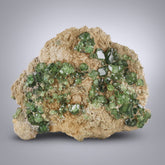

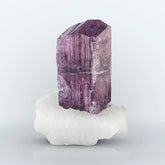

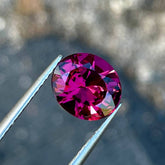






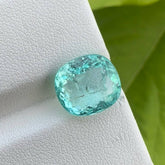

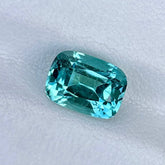

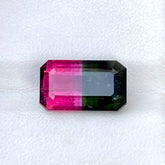

Leave a comment
Please note, comments need to be approved before they are published.